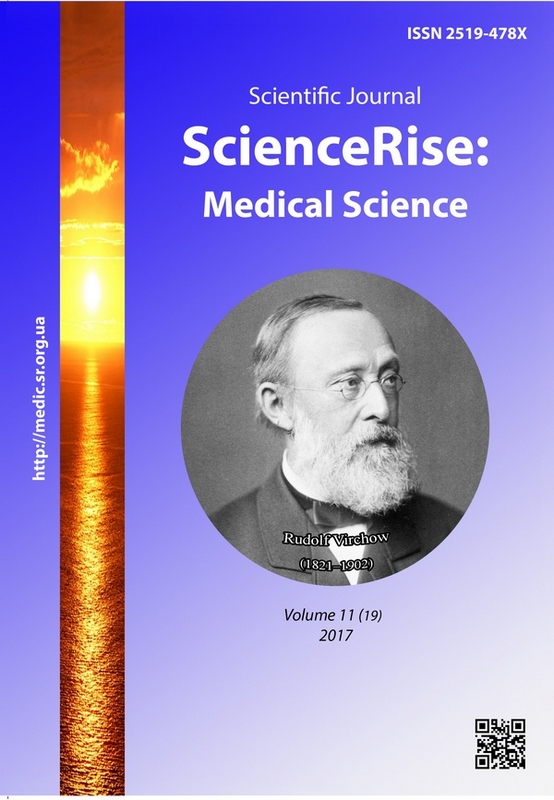Визначення ролі біомаркерів сигнального шляху кальціневрину у розвитку ранніх змін в міокарді у дітей з двостулковим аортальним клапаном серця
DOI:
https://doi.org/10.15587/2519-4798.2017.116752Ключові слова:
двостулковий аортальний клапан, діти, гіпертрофія міокарда, кальціневрин, білок S100, інтерлейкін-2, кальційАнотація
В результаті дослідження вмісту сироваткових концентрацій кальціневрину, білка S100, інтерлейкіну-2, у дітей з двостулковим аортальним клапаном встановлена наявність помірної гіпертрофії міокарду, збільшення градієнту тиску та швидкості кровотоку на аортальному клапані, зниження рівнів кальціневрину та загального кальцію, збільшення концентрації білка S100 при негативному впливі цих показників на геометрію правих відділів серця
Посилання
- Takano, H., Zou, Y., Akazawa, H., Nagai, T., Mizukami, M., Toko, H., & Komuro, I. (2003). Ca2+ – Dependent Signaling Pathways Through Calcineurin and Ca2+ Calmodulin – Dependent Protein Kinase in Development of Cardiac Hypertrophy. Progress in Experimental Cardiology, 85–94. doi: 10.1007/978-1-4615-0347-7_7
- Rich, R. R., Fleisher, T. A., Shearer, W. T., Chroeder, H., Frew, A. J., Weyand, C. M. (2012). Clinical Immunology E-Book: Principles and Practice. Elsevier Health Sciences, 1500.
- McPherson, R., Pincus, M. (2011). Henry's Clinical Diagnosis and Management by Laboratory Methods. Elsevier, 1568.
- Holton, M. (2009). PMCA as a Regulator of Calcium. University of Wolverhampton, 124.
- Wu, B., Baldwin, H. S., Zhou, B. (2013). Nfatc1 directs the endocardial progenitor cells to make heart valve primordium. Trends in Cardiovascular Medicine, 23 (8), 294–300. doi: 10.1016/j.tcm.2013.04.003
- Polovkova, O. G. (2013). Rol' genov signal'nogo puti kal'cinevrina v razvitii remodelirovaniya miokarda u bol'nyh ishemicheskoy bolezn'yu serdca. Tomsk, 23.
- Chapman, A. (Ed.) (2015). Bicuspid Aortic Valve: Diagnosis, Surgical Treatment and Complications. Nova Science Pub Inc, 75.
- Niwa, K., Kaemmerer, H. (Eds.) (2017). Aortopathy. Springer, 333. doi: 10.1007/978-4-431-56071-5
- Wolska, B. M. (2009). Calcineurin and cardiac function: is more or less better for the heart? AJP: Heart and Circulatory Physiology, 297 (5), H1576–H1577. doi: 10.1152/ajpheart.00833.2009
- Kehat, I., Molkentin, J. D. (2010). Molecular Pathways Underlying Cardiac Remodeling During Pathophysiological Stimulation. Circulation, 122 (25), 2727–2735. doi: 10.1161/circulationaha.110.942268
- Poirier, O., Nicaud, V., McDonagh, T., Dargie, H. J., Desnos, M., Dorent, R. et. al. (2003). Polymorphisms of genes of the cardiac calcineurin pathway and cardiac hypertrophy. European Journal of Human Genetics, 11 (9), 659–664. doi: 10.1038/sj.ejhg.5201023
- Linde, E. V., Ahmetov, I. I., Ordzhonikidze, Z. G., Astratenkova, I. V., Fedotova, A. G. (2009). Vliyanie polimorfizmov genov ASE, RRARA, PPARD i NFATC4 na kliniko-funkcional'nye harakteristiki sportivnogo serdca. Mezhdunarodnyy zhurnal intervencionnoy kardioangiologii, 17, 50–56.
- Wang, X., Wang, M. (2010). The S100 protein family and its application in cardiac diseases. World J. Emerg. Med., 1 (3), 165–168.
- Wang, D., Fang, J., Wang, R., Sun, D., Xia, K., Yin, W. et. al. (2016). Elevated serum ghrelin, tumor necrosis factor-α and interleukin-6 in congenital heart disease. Pediatrics International, 58 (4), 259–264. doi: 10.1111/ped.12773
- Madhok, A. B., Ojamaa, K., Haridas, V., Parnell, V. A., Pahwa, S., Chowdhury, D. (2006). Cytokine Response in Children Undergoing Surgery for Congenital Heart Disease. Pediatric Cardiology, 27 (4), 408–413. doi: 10.1007/s00246-006-0934-y
- Siu, S. C., Silversides, C. K. (2010). Bicuspid Aortic Valve Disease. Journal of the American College of Cardiology, 55 (25), 2789–2800. doi: 10.1016/j.jacc.2009.12.068
##submission.downloads##
Опубліковано
Як цитувати
Номер
Розділ
Ліцензія
Авторське право (c) 2017 Andrey Kamenshchyk

Ця робота ліцензується відповідно до Creative Commons Attribution 4.0 International License.
Наше видання використовує положення про авторські права Creative Commons CC BY для журналів відкритого доступу.
Автори, які публікуються у цьому журналі, погоджуються з наступними умовами:
1. Автори залишають за собою право на авторство своєї роботи та передають журналу право першої публікації цієї роботи на умовах ліцензії Creative Commons CC BY, котра дозволяє іншим особам вільно розповсюджувати опубліковану роботу з обов'язковим посиланням на авторів оригінальної роботи та першу публікацію роботи у цьому журналі.
2. Автори мають право укладати самостійні додаткові угоди щодо неексклюзивного розповсюдження роботи у тому вигляді, в якому вона була опублікована цим журналом (наприклад, розміщувати роботу в електронному сховищі установи або публікувати у складі монографії), за умови збереження посилання на першу публікацію роботи у цьому журналі.










